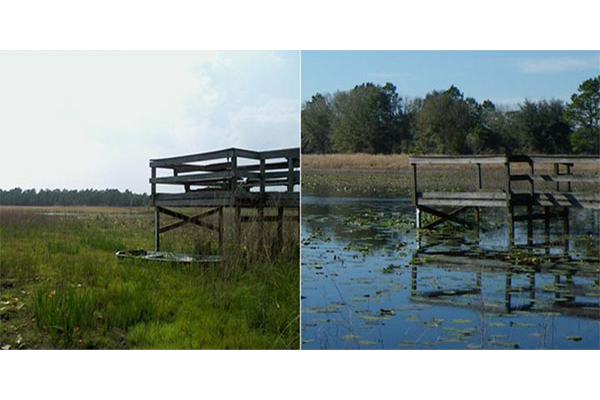
Still image from video "Worried About Water? Tracking Climate Assures Supply." Video footage: Kurt Mann
Overuse of groundwater by the Tampa Bay metro area drained wetlands and caused severe degradation of natural resources, such as Stanford Lake (left). A new strategy using multiple water sources has allowed many areas to recover (right). Photos courtesy Tampa Bay Water. Large images: 2002 | 2011
Climate change impacts
Tampa Bay in Florida, USA, faces several climate change issues including drought, increased storms, flooding, and saltwater intrusion. In the early 2000s, Tampa Bay Water started using groundwater for surface water shortages caused by prolonged periods of drought. However, groundwater irrigation has reduced the water level of local wetlands and lakes, negatively affected ecosystems, and caused the loss of wildlife habitats.
Adaptation activity
Tampa Bay Water recognizes that it needs to supply customers as well as protect the environment. To do this, tools for predicting reductions in surface water supply are necessary.
Projections (see Note 1) provided by the NOAA Climate Prediction Center (see Note 2) were used to assess temperature and precipitation patterns for periods of weeks to months. A particularly significant factor affecting Florida's climates is the El Nino Southern Oscillation (ENSO) (Note 3), which has been found to be a reliable indicator of Florida's wet and dry periods. Using research based on ENSO data, forecasts and significant insights could be provided for water management purposes. As a result, water supply administrators are able to make decisions on groundwater conservation and ecosystem protection in a timely manner during periods when there is a shortage of surface water.
Reservoirs for storage surface water and a desalination plant to replenish freshwater have also been constructed in anticipation of dry periods, and to increase drought resilience. Today, Tampa Bay Water utilizes a combination of three resources: surface water from rivers and reservoirs, groundwater from wells, and desalinized seawater from Tampa Bay. The use of these different water sources incurs different respective costs, and this must be considered when delivering supply.
Outputs / Expected benefits
Factoring in ENSO has enabled economically and environmentally viable storage and intake, pumping, and desalination plant operations. While it is difficult to balance the three water sources to keep costs down while maintaining a high quality of life, climate projections have made management easier. In addition, new strategies using multiple water sources have resulted in the recovery of natural resources in many locations.

Lake Stanford depleted by overuse (left), restored through diversifying water supply (right)
(Source: U.S. Climate Resilience Toolkit "Climate Outlooks Help Water Supply Planning")




